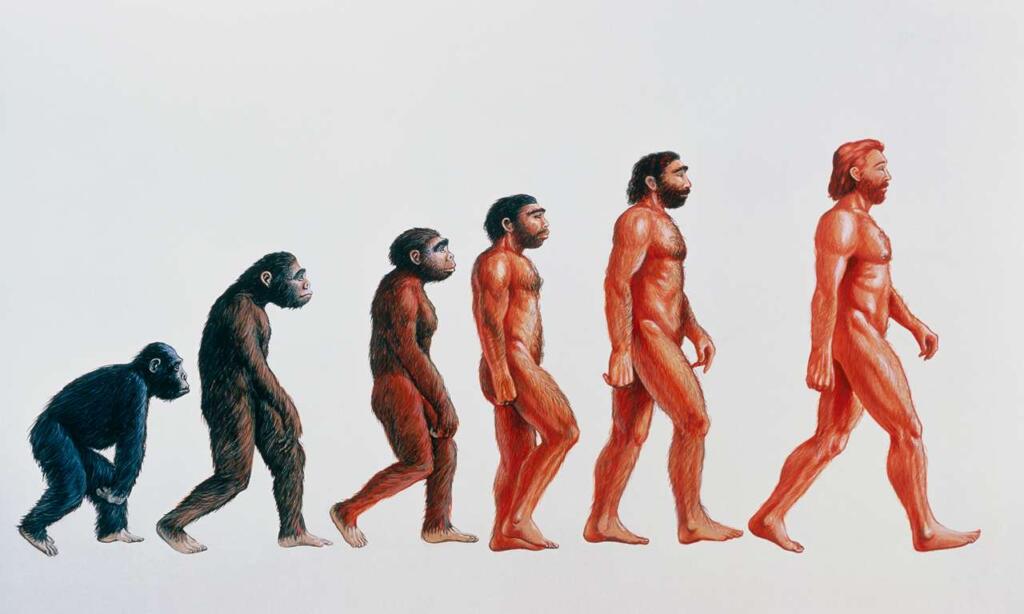In the tapestry of human history, walking stands as a testament to our evolutionary progress. Like a delicate brushstroke on a canvas, it is an intricate dance between biology and environment, shaped by forces beyond our control.
As we traverse the world on two legs, we may find ourselves wondering: who invented walking? While no single individual can claim this honor, the origins of bipedalism lie deep within the annals of time. Through millions of years of evolution, our ancestors transitioned from walking on all fours to standing tall and striding with purpose. This transformative shift paved the way for countless advancements and opportunities.
But why did humans evolve to walk upright? The answer lies in a complex interplay between anatomical adaptations and environmental pressures. By exploring the fossils of early hominins such as Sahelanthropus tchadensis and Homo erectus, we gain invaluable insights into this fascinating journey.
Join us as we delve into the mysteries surrounding the invention of walking and unravel its profound impact on human existence.

Key Takeaways
- Walking upright is a human characteristic evolved from ancestors who walked on all fours.
- Bipedalism is not exclusive to humans and can be seen in other animals.
- The earliest known bipedal creature is the Eudibamus reptile, but its extent of bipedalism is still debated.
- Humans evolved from a lineage of extinct primates called Hominins.
A look at bipedalism
Bipedalism, a characteristic evolved from ancestors who walked on all fours, is not exclusive to humans and can be observed in various other animals. The ability to walk upright on two legs has been advantageous for many species as it allows for increased visibility, efficient locomotion, and the use of hands for other tasks.
In humans, bipedalism is attributed to a combination of anatomical features such as shorter arms, a unique pelvic shape, and a curved spine. Fossil records and comparative anatomy studies provide evidence of bipedalism in early hominins such as Ardipithecus ramidus, Australopithecus afarensis, Homo habilis, and Homo erectus.
While the exact reasons for the evolution of bipedalism are speculative, theories suggest that it may have facilitated easier food gathering, self-defense against predators or rival groups, adaptation to changing environments, and the freeing up of hands for tool use. Additionally, walking upright may have contributed to improved cognitive development and the rise of technology in human evolution.
Understanding the origins and development of bipedalism provides valuable insights into our evolutionary history.
Who invented walking the way humans do today?
The evolution of human walking is a topic that has fascinated scientists for centuries. By studying the fossil record and comparative anatomy, researchers have gained insights into the development of bipedalism in our ancestors.
From early hominins like Ardipithecus ramidus and Australopithecus afarensis to later species like Homo habilis and Homo erectus, evidence suggests a gradual transition from a four-legged gait to fully upright walking.
Understanding the origins of human walking not only sheds light on our evolutionary history but also provides valuable information about the unique characteristics that distinguish us as a species.
Human evolution and walking
The discussion on the subtopic of human evolution and walking involves the examination of key species such as Orrorin tugenensis, Ardipithecus ramidus, Australopithecus afarensis, Homo habilis, and Homo erectus.
Orrorin tugenensis is significant as it showed evidence of bipedalism through its femurs.
Ardipithecus ramidus had foot structure and pelvic bones indicative of bipedal walking.
Australopithecus afarensis had fossils and footprints that provided further evidence for bipedal locomotion.
Homo habilis walked on two legs but still retained long arms like apes, while Homo erectus exhibited various adaptations for bipedal walking including shorter arms, longer legs, stronger knees, angled femurs, a curvier spine, and more hip support.
By analyzing these species through an objective and evidence-based approach, we can gain insights into the evolutionary development of walking in humans.
Orrorin tugenensis
Orrorin tugenensis, an early hominin species, provides significant evidence of bipedalism through its well-preserved femur bones. This species adds to our understanding of the evolution of walking by showcasing anatomical adaptations indicative of bipedal locomotion.
Here are three key features observed in Orrorin tugenensis:
- Femur morphology: The shape and structure of the femur bone suggest that Orrorin tugenensis had a more human-like gait compared to other primates.
- Proportional length: Orrorin tugenensis had longer legs relative to their arm length, which is consistent with a bipedal mode of locomotion.
- Weight-bearing characteristics: The femur bones show signs of weight-bearing adaptations, such as thickening and robustness, supporting the hypothesis that Orrorin tugenensis walked upright.
These findings contribute to our understanding of the evolutionary path towards fully bipedal hominins and shed light on the development of walking in our early ancestors.

Ardipithecus ramidus
Ardipithecus ramidus, an early hominin species, provides crucial insights into the evolution of bipedalism through its unique foot structure and pelvic bones.
The foot structure of Ardipithecus ramidus indicates adaptations for bipedal walking, with a curved big toe and a stiff midfoot.
Additionally, its pelvis exhibits features that suggest weight-bearing capabilities during upright locomotion.
These findings contribute to our understanding of the development and adaptation of bipedalism in early hominins.
Australopithecus afarensis
Moving on from Ardipithecus ramidus, another important species in the study of walking evolution is Australopithecus afarensis. Fossil evidence and preserved footprints indicate that A. afarensis had a bipedal gait similar to modern humans.
The structure of their feet and pelvis further supports this conclusion. These findings suggest that bipedalism was already well-established in the hominin lineage by the time of Australopithecus afarensis, contributing to our understanding of the development of walking in our ancestors.
Homo habilis
Homo habilis, an early hominin species, exhibited a bipedal gait characterized by shorter arms similar to apes. This species had several anatomical features that supported their ability to walk upright.
These include:
- Longer legs
- Stronger knees
- Angled femurs
- A curvier spine
- More hip support
These adaptations allowed Homo habilis to move efficiently on two legs and likely played a crucial role in their survival and success as early humans.
Homo erectus
Advancements in anatomical features allowed early hominins to adopt a new mode of locomotion, enabling them to navigate their environment with greater efficiency and adaptability.
Homo erectus, a species that lived approximately 1.9 million to 143,000 years ago, displayed significant anatomical changes compared to its predecessors. It had shorter arms, longer legs, stronger knees, angled femurs, a curvier spine, and more hip support for bipedal walking.
These adaptations are indicative of an increased reliance on walking as the primary mode of locomotion in Homo erectus.
Why did humans evolve to walk?
The evolution of bipedalism in humans can be attributed to several factors. Firstly, walking upright made gathering food easier as it allowed our ancestors to cover larger distances more efficiently, enabling them to access a wider range of resources.
Additionally, walking on two legs provided an advantage in self-defense by freeing up the hands for tool use or carrying weapons.
Furthermore, environmental changes such as the expansion of savannahs may have favored bipedalism as it improved visibility and allowed for better thermoregulation while traversing open landscapes.
Overall, the development of bipedalism in humans was likely a complex process influenced by multiple factors that conferred evolutionary advantages.
It made gathering food easier
An important advantage of walking upright is that it potentially made the gathering of food easier for our ancestors. This is supported by several factors:
- Increased visibility: Walking upright allowed early humans to have a better view of their surroundings, enabling them to spot potential sources of food such as fruits, nuts, and small animals more easily.
- Efficient movement: Bipedalism allowed our ancestors to cover longer distances with less energy expenditure compared to quadrupedal locomotion. This would have been beneficial when searching for food across larger areas.
- Improved tool use: Walking on two legs freed up the hands for other tasks, including the development and use of tools. Tools could be used for hunting or processing food, further enhancing our ancestors’ ability to gather resources.
These advantages likely contributed to the evolution and persistence of bipedalism in human ancestors, making walking an essential adaptation for survival and successful resource acquisition.
It made self-defense easier
Enhanced physical stature allowed for increased self-defense capabilities in early humans, potentially aiding in their survival and protection against threats within their environment. The evolution of bipedalism played a crucial role in this aspect. Bipedalism freed up the hands, allowing them to use tools or weapons more effectively in confrontations with predators or other hostile individuals.
Additionally, the ability to walk upright provided better visibility and awareness of the surroundings, enabling early humans to detect potential threats from a distance. This enhanced sense of vigilance likely contributed to their ability to avoid dangerous situations and protect themselves from harm.
Thus, walking upright not only facilitated easier food gathering but also improved self-defense capabilities in early humans.
The environment changed
One significant factor that influenced the evolution of upright walking in early humans was a shift in their surrounding environment. This change in the environment provided both challenges and opportunities for our ancestors, ultimately leading to the development of bipedalism.
Challenges:
- Changes in vegetation and landscape may have required our ancestors to navigate uneven terrain, forcing them to adapt by walking on two legs.
- Environmental changes such as the spread of grasslands may have favored bipedalism as it allowed for better visibility over tall grasses, enhancing survival.
Opportunities:
- The new environment may have presented different food sources that required more efficient locomotion, encouraging the evolution of upright walking.
- Bipedalism would have also freed up our ancestors’ hands, allowing them to carry tools or gather resources more effectively.
By adapting to these environmental changes through upright walking, early humans gained advantages in terms of mobility, accessing resources, and survival.
It freed our hands
By adopting upright walking, early humans unlocked the potential of their hands, liberating them to manipulate their environment and forge an innovative path towards progress. Walking on two legs allowed our ancestors to free up their hands for various tasks, such as gathering food, making tools, and creating shelter. This newfound freedom provided a significant advantage in survival and adaptation. The ability to use their hands effectively enabled early humans to develop complex social structures, communicate through gestures and sign language, and eventually invent written language.
In addition, it allowed for the development of fine motor skills necessary for crafting intricate tools and engaging in activities like art and music. Ultimately, the evolution of bipedalism and the liberation of our hands played a crucial role in shaping human civilization as we know it today.
| Benefit | Explanation |
|---|---|
| Enhanced Manipulation | Upright walking freed up our hands to perform precise tasks such as tool-making or playing musical instruments. |
| Increased Efficiency | Bipedalism allowed for more efficient movement while carrying objects or performing multiple tasks simultaneously. |
| Social Interaction | The ability to use hand gestures facilitated non-verbal communication and strengthened social bonds within communities. |
| Cognitive Development | The increased dexterity of our hands contributed to enhanced cognitive abilities by supporting complex problem-solving skills and creative expression. |
This table illustrates how freeing up our hands through upright walking had far-reaching implications that extended beyond physical advantages alone.

Walking in contemporary times
Walking is a popular recreational activity that is enjoyed by people of all ages and fitness levels. It offers numerous physical and mental health benefits, making it an accessible and enjoyable form of exercise.
Walking has been shown to improve cardiovascular fitness, strengthen muscles, reduce the risk of chronic diseases such as heart disease and diabetes, and contribute to weight management. Additionally, walking can have positive effects on mental well-being by reducing stress, improving mood, and promoting cognitive function.
Many individuals also find walking to be a great way to connect with nature and enjoy the outdoors. Moreover, walking events such as charity walks or community walks provide opportunities for social interaction and fundraising for important causes.
Overall, walking continues to be a widely appreciated activity that promotes both physical health and overall well-being.
Conclusion
To summarize, the evolution and significance of bipedalism in humans provide valuable insights into our ancestral history and the adaptations that allowed us to walk upright. Bipedalism has played a crucial role in human survival and development.
Here are two key points to consider:
- Evolutionary advantages: Walking on two legs freed up our hands for other tasks, such as tool use and communication. It also improved our ability to cover long distances efficiently, aiding in food gathering and migration. Additionally, walking upright may have contributed to better cognitive development, leading to the rise of technology and complex societies.
- Cultural significance: Walking has evolved beyond a mere survival adaptation. In contemporary times, it serves various purposes like relaxation, fun, exercise, and charity events. The ancient Romans even used walking to measure distance and invented power walking and speed walking as competitive sports. Today, race walking is an Olympic sport.
Understanding the origins of bipedalism sheds light on our shared ancestry with other primates and helps us appreciate the unique trait of walking that defines us as humans.
Frequently Asked Questions
How did the early bipedal creatures, such as Eudibamus reptile, walk?
The early bipedal creature, Eudibamus reptile, likely walked with an upright posture similar to modern reptiles. While the extent of its bipedalism is debated, it is believed to have used its hind limbs for locomotion.
What are the physical characteristics that enable humans to walk upright?
Physical characteristics that enable humans to walk upright include shorter arms, a specific shape of the pelvis, and a curved spine. These adaptations evolved over time in our hominin ancestors to facilitate efficient bipedal locomotion.
What are some speculated reasons for humans evolving to walk upright?
Some speculated reasons for humans evolving to walk upright include easier food gathering, self-defense, environmental changes, and freeing up hands for other tasks. Walking upright may have also contributed to better cognitive development and the rise of technology.
How has walking evolved and changed in contemporary times?
Walking has evolved and changed in contemporary times by becoming a popular recreational activity, a means of transportation, a competitive sport (such as race walking), and a way to raise money for charity.
What are some key insights from the study of early hominins that contribute to our understanding of walking?
Key insights from the study of early hominins contribute to our understanding of walking. These include evidence of bipedalism in species such as Ardipithecus ramidus and Australopithecus afarensis, which provide insight into the evolution and development of walking in human ancestors.
Additionally, the comparison between different hominin species like Homo habilis and Homo erectus helps us understand the changes in limb strength and locomotion that occurred over time. The examination of fossil remains, footprints, skeletal structures, and genetic studies allows researchers to reconstruct the evolutionary history of walking and its significance in human evolution.

















